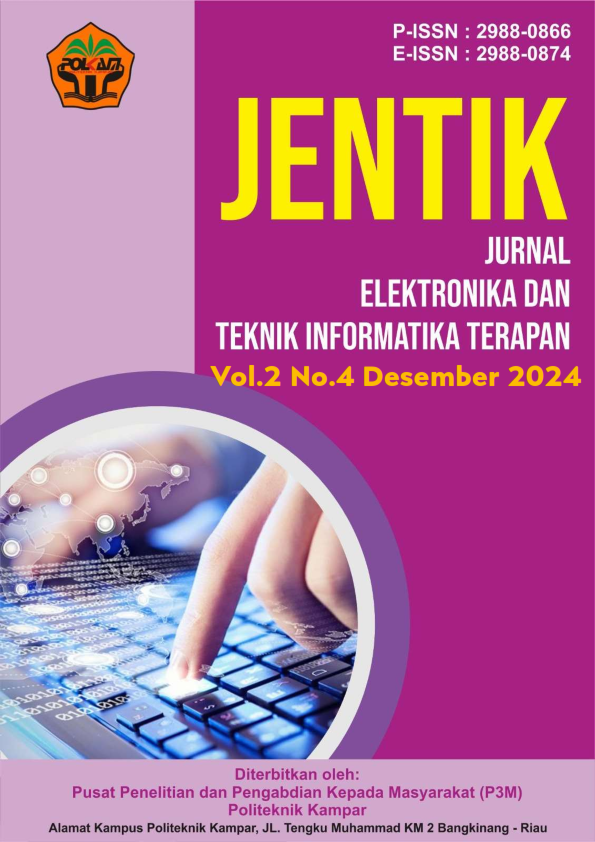Analisis dan Perancangan Sistem Informasi Manajemen Rantai Pasokan Perusahaan Pengelola Objek Wisata
DOI:
https://doi.org/10.59061/jentik.v2i4.806Keywords:
Operational Efficiency, Supply Chain Management, Information System, TourismAbstract
Integrated supply chain management is key in maintaining operational efficiency in the tourism sector, especially in high-demand tourist destinations such as Taman Ria. This research aims to analyze and design a Supply Chain Management Information System (SIMRP) that can integrate various elements of the supply chain at Taman Ria, from procurement, inventory management, to collaboration with suppliers. This research uses the Design Thinking method and Business Process Model and Notation (BPMN) to design a supply chain management information system that is effective and in accordance with user needs. The stages in Design Thinking that will be implemented include four main steps, namely empathize, define, ideate, prototype. The result of this research is that the implementation of the Supply Chain Management Information System (SIMRP) with the Design Thinking method and Business Process Model and Notation (BPMN) can effectively improve operational efficiency in tourist attraction management companies. With SIMRP, all processes from procurement, inventory management, to distribution can be automated and integrated into a unified system. This makes it easier for companies to monitor the flow of goods and information in real-time, so that decision-making can be done more quickly and based on accurate data. In addition, the involvement of BPMN in business process modeling enables a clear visual representation, making process identification and improvement easier.
References
Azizah, N., Putra, W. H. N., & Az-Zahra, H. M. (2022). Perancangan sistem informasi platform manajemen rantai pasok dengan metode design thinking pada usaha mikro kecil dan menengah (UMKM) menggunakan payment gateway Midtrans. Jurnal Pengembangan Teknologi Informasi dan Ilmu Komputer, 6(5), Article 5.
Cuandra, F., Maytanius, J., Leonardo, D. T., Sembiring, R., & Lim, R. (2022). Pengaruh manajemen rantai pasok berbasis ERP dalam meningkatkan kinerja PT. Furnitur Batam Bina Perkasa. Transekonomika: Akuntansi, Bisnis dan Keuangan, 2(4), Article 4. https://doi.org/10.55047/transekonomika.v2i4.141
Djamaris, A. R. (2024). Design thinking: Menyelesaikan masalah dengan kreativitas. Retrieved November 10, 2024, from https://repository.bakrie.ac.id/7760/
Halimah, N. N., Witanti, W., & Sabrina, P. N. (2020). Perancangan sistem supply chain management proses produksi pakan burung di CV Ebod Jaya. In Seminar Nasional Teknologi Komputer & Sains (SAINTEKS), 1(1), Article 1.
Khairy, M. S. (2022). Penerapan design thinking pada perancangan UI/UX marketplace sistem rantai pasok ‘panen-panen.’ Jurnal Informatika Polinema, 8(3), Article 3. https://doi.org/10.33795/jip.v8i3.818
Mahendra, R. A., et al. (2023). Analisa penerapan sistem enterprise resource planning dan manajemen rantai pasokan pada PT Semen Padang dalam meningkatkan kinerja perusahaan. REVITALISASI: Jurnal Ilmu Manajemen, 12(1), Article 1. https://doi.org/10.32503/revitalisasi.v12i1.3766
Pardede, D. H., & Mailangkay, S. T. A. B. L. (2021). Perancangan user interface berbasis web pendistribusian barang (supply chain management) menggunakan metode design thinking. In Prosiding Seminar Nasional, 1, 38–41.
Putrayasa, G. E., & Widyanesti, S. (2021). Analisis pemanfaatan sistem informasi manajemen dalam pengoptimalan rantai pasok PT. XYZ. eProceedings of Management, 8(6). Retrieved November 10, 2024, from https://openlibrarypublications.telkomuniversity.ac.id/index.php/management/article/view/16890
Rifqi, A. (2023). Mengoptimalkan manajemen rantai pasok melalui sistem informasi terintegrasi. Jurnal Teknologi Terkini, 3(8), Article 8. Retrieved October 29, 2024, from http://teknologiterkini.org/index.php/terkini/article/view/469
Shihab, F. M., & Persada, A. G. (2022). Pengembangan sistem informasi manajemen objek wisata rintisan berbasis platform menggunakan framework PHP. SNATI, 2(1), Article 1. https://doi.org/10.20885/snati.v2i1.15
Sholiq, S., Sarno, R., & Astuti, E. S. (2022). Generating BPMN diagram from textual requirements. Journal of King Saud University - Computer and Information Sciences, 34(10), 10079–10093. https://doi.org/10.1016/j.jksuci.2022.10.007
Syamil, A., et al. (2023). Buku ajar manajemen rantai pasok. PT. Sonpedia Publishing Indonesia.
Wibowo Putro, P. A., Purwaningsih, E. K., Sensuse, D. I., Suryono, R. R., & Kautsarina. (2022). Model and implementation of rice supply chain management: A literature review. Procedia Computer Science, 197, 453–460. https://doi.org/10.1016/j.procs.2021.12.161
Yuan, H., Qiu, H., Bi, Y., Chang, S.-H., & Lam, A. (2023). Retraction note: Analysis of coordination mechanism of supply chain management information system from the perspective of blockchain. Information Systems and E-Business Management, 21(1), 43. https://doi.org/10.1007/s10257-022-00612-0
Downloads
Published
How to Cite
Issue
Section
License
Copyright (c) 2024 Jurnal Elektronika dan Teknik Informatika Terapan ( JENTIK )

This work is licensed under a Creative Commons Attribution-NonCommercial-ShareAlike 4.0 International License.








